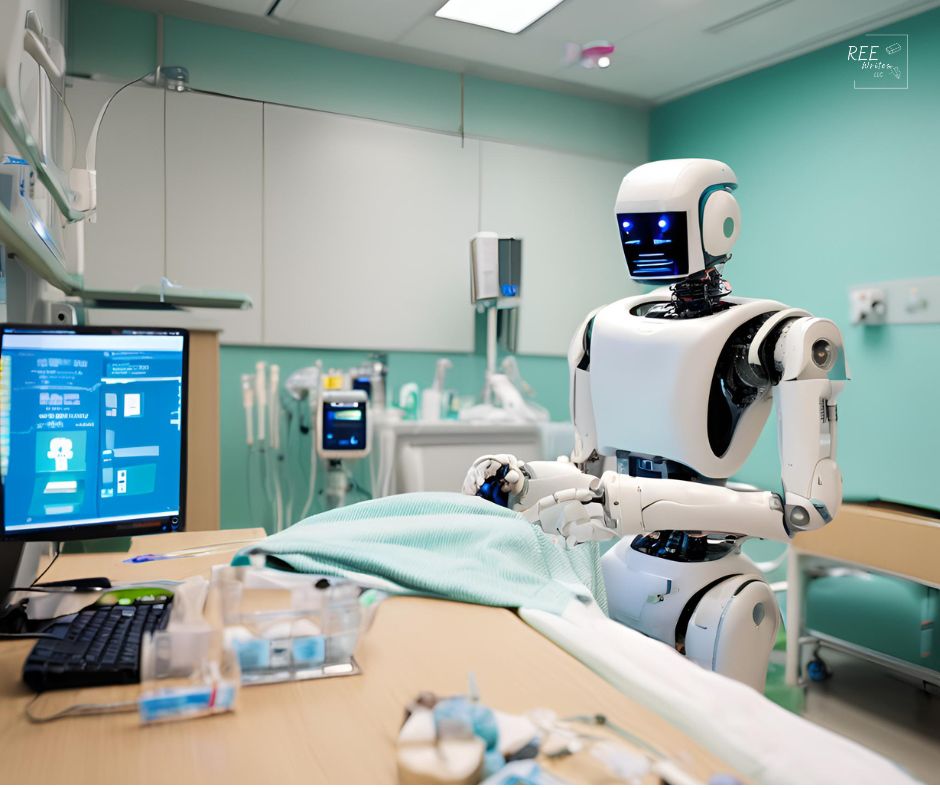Since the onset of the pandemic, more healthcare workers and clinicians have experienced burnout, leading to dissatisfaction among both patients and clinicians. Overworked clinicians often make errors in their documentation, and their lack of time and stressed demeanor can erode the trust between physicians and patients. Dissatisfied and neglected patients are less likely to engage with their care, adhere to care plans, and follow preventive healthcare advice, increasing the likelihood of adverse outcomes (DeepScribe, 2023).
In Medscape’s 2021 physician survey, 42% of physicians reported feeling burned out, citing “too many bureaucratic tasks” and “spending too many hours at work” as the main causes. Providers often spend hours documenting patient care, and the administrative burden often stretches into their own time. The Association of American Medical Colleges projects a shortfall of nearly 122,000 physicians in the US by 2032 (Harper, 2022).
Ambient Clinical Intelligence (ACI) is a technology that can help alleviate the burden of medical documentation for clinicians, among many other benefits we’ll explore in this article. But first, let’s get a better understanding of ACI.
Contents
What is Ambient Clinical Intelligence?

ACI brings together several technologies that work together to improve healthcare:
- Ambient intelligence
- Artificial intelligence (AI)
- Data analytics
- Internet of Things (IoT)
- Natural Language Processing (NLP)
ACI in healthcare includes IoT-based tools such as temperature and humidity sensors, blood pressure monitors, and other devices that autonomously collect data and continuously update doctors on the vital statistics of critical patients (Joshi, 2022).
“Imagine a hospital where every room, every corridor, every piece of equipment is interconnected, constantly gathering data, analyzing it, and providing insights,” says Jon Morgan, CEO and Editor-in-Chief of VentureSmarter. “It means doctors and nurses have access to a wealth of information right at their fingertips, allowing for quicker and more accurate diagnoses. This can significantly improve patient outcomes because decisions are based on a comprehensive analysis of real-time data rather than just a snapshot in time.”
Let’s explore how ACI can make healthcare tasks more efficient in both healthcare settings and patients’ homes.

ACI Use Cases for Clinical Spaces
ACI can improve the quality of health services by making many processes more efficient, such as:
- Transcribing medical notes
- Creating reports
- Patient monitoring
This section describes some of ACI’s biggest benefits in healthcare settings.
Clinical documentation during patient care

ACI technology can help alleviate the burden of medical documentation for clinicians, allowing them to give their full attention to patients during visits while ACI creates accurate clinical notes directly in the electronic health record (EHR) for review (Augnito, 2023). (This a concept included in the fancier term, “AI-powered medical documentation automation.”) ACI can also spot indicators of depression, anxiety, and social determinants of health (SDoH) during patient-physician conversations (Harper, 2022).
In one study, a deep learning (DL) model trained on 14,000 hours of outpatient audio from 90,000 conversations between patients and physicians. The transcription accuracy of the DL version was 80%, compared to 76% accuracy by medical scribes (Haque et al., 2020).
In another example, a medical provider found that microphones attached to eyeglasses reduced documentation time from 2 hours to just 15 minutes. This huge time savings doubled the time spent with patients (Haque et al., 2020).
By automating routine tasks and documentation, ACI allows healthcare providers to spend more time focusing on direct patient care, leading to patient satisfaction.
Patient satisfaction

The automation of ACI can help strengthen the patient-physician relationship and increase patient satisfaction, engagement, and retention.
“Using systems that can automatically monitor patients’ vital signs, track medication administration, and even predict potential complications,” Morgan says. “Healthcare professionals can focus more on direct patient care rather than spending time on administrative tasks. This improves the overall quality of care while also reducing the burden on healthcare workers in today’s overstretched healthcare systems.”
Tests and reports
With ACI tools, hospitals can conduct tests on patients and monitor them autonomously with wireless sensors and wearable devices.
For example, an ambient intelligence sensor monitors a patient’s health by dynamically tracking their vitals. First, it collects and assesses vitals, body fat, blood sugar, cholesterol levels, and other details. Then it can create a report listing potential illnesses and recommendations on diagnoses, medical coding, diet, medications, and lifestyle (Joshi, 2022).
By enhancing data interoperability, ACI eliminates the need for redundant paperwork and testing. ACI can streamline care coordination by compiling data from various sources into consolidated dashboards, providing clinicians with a holistic view of each patient. Reviewing these dashboards can help them better understand their patients’ clinical history, medications, test results, and more (Augnito, 2023).
Tracking infectious disease
IoT, thermal vision cameras, and AI can check infected zones, such as surfaces where infectious viruses are found, and ensure they are cleaned and decontaminated. Thermal vision cameras are also useful for monitoring crowded areas and tracking individuals who may carry a contagious disease (Joshi, 2022).
Surgical training
In the operating room (OR), ambient cameras can be used for endoscopic videos to improve surgical training. Ambient intelligence can also account for surgical objects in the OR, including those that could be left inside a patient during a procedure, to mitigate staff errors (Haque et al., 2020).
Continuous patient monitoring in the ICU
In one study, ambient sensors in hospital intensive care units (ICUs) monitored the movements of patients, clinicians, and visitors with over 85% accuracy.
In another study, sensors installed above hand sanitizer dispensers across a hospital unit were 75% accurate in measuring handwashing compliance within one hour, while a human observer was only 63% accurate (Haque et al., 2020).

Observing patients post-surgery
Ambient intelligence in recovery rooms post-op can continuously observe recovery-related behaviors, giving providers insight into movement and other activities. This can reduce recovery time and improve post-surgical outcomes (Joshi, 2022).
While ACI offers numerous benefits in clinical spaces, its potential extends beyond hospital walls.
ACI for Aging in Place: Enhancing Independent Living
By 2050, the world’s population aged 65 years or older will increase from 700 million to 1.5 billion (Haque et al., 2020). As people live longer, their independent living, chronic disease management, physical rehabilitation, and mental health become paramount.
Promoting autonomy for patients with remote patient monitoring (RPM)
Activities of daily living (ADLs), such as bathing, dressing, and eating, are critical to the well-being and independence of aging adults. Aging and elderly patients living at home are at an increased risk for falls, accidents, and emergencies. Impairment in performing ADLs is associated with a twofold increased risk of falling, and up to a fivefold increase in the one-year mortality rate (Haque et al., 2020).
RPM through ACI can analyze their daily activities to detect significant changes that may need a closer look. It can also help identify changes in vital signs, movement patterns, sleep rhythms, behaviors, and emerging symptoms that may signal a decline in a patient’s quality of life. Ambient-assisted living using the ACI-RPM combo can also monitor patients for early signs of dementia and Alzheimer’s.
“The constant monitoring and analysis of patient data in real-time can help in early detection of health issues,” says Collen Clark, Medical Malpractice Lawyer and Founder of Schmidt & Clark LLP. “This allows for quicker interventions and personalized treatment plans, while reducing the risk of medical errors, which can have legal implications related to negligence or malpractice.”
Any concerning findings from RPM automatically trigger alerts to healthcare providers, allowing them to intervene early with quick, proactive outreach to patients in need. This can prevent avoidable ER visits, hospitalizations, and health emergencies (Augnito, 2023).
Wearable sensors for monitoring and fall detection in seniors

Wearable devices such as accelerometers or electrocardiogram sensors can track not only ADLs but also heart rate, glucose level, and respiration rate. They can even remind patients to take their medications (Haque et al., 2020), and detect falls.
As wearable devices and IoT ecosystems in healthcare continue to expand, integrating them with ACI systems can provide continuous personalized monitoring and truly ambient intelligent care.
Patients can get proactive alerts about potential health issues before they become critical, and get customized recommendations. Streamlining the flow of data from personal sources like fitness trackers to electronic health records via ACI can massively enrich patient profiles for highly tailored care (Augnito, 2023).
Ambient sensors
In one study, researchers installed a depth and thermal sensor inside the bedroom of an older individual and observed 1,690 activities during one month, including 231 instances of caregiver assistance. A convolutional neural network was 86% accurate at detecting assistance. In a different study, researchers collected ten days of video from six individuals in an elderly home and achieved similar results (Haque et al., 2020).
Although the data from visual sensors are promising, they raise privacy concerns in some places like bathrooms, where grooming, bathing and toileting activities occur. To counter this, researchers also explored acoustic and radar sensors. One study used microphones to detect showering and toileting activities with accuracy rates of 93% and 91%, respectively (Haque et al., 2020).
ACI has tremendous potential. However, it’s important to consider some challenges and limitations.
ACI Caveats and Considerations

The use cases and benefits of ACI are remarkable, but as with any technology, there are still considerations to gain its maximum benefit in the larger healthcare ecosystem.
Bias
ACI systems are dependent on the quality of data used to train algorithms. If that data reflects societal biases, the AI could make flawed judgments and recommendations. There’s also the risk of over-reliance on AI diagnostics versus human expertise. Careful oversight is required to audit algorithms and ensure AI transparency in clinical decision-making (Augnito, 2023).
Data privacy and security
There is a heightened risk of unauthorized access or breaches with ACI. Patients have a right to understand how their data is used with ACI tools during consultations and treatment. Health providers should disclose this information and request patient consent, which is optional.
“With the continuous stream of patient data being collected, stored, and analyzed by ACI systems, there’s a heightened risk of unauthorized access or breaches,” Clark says. “I would advise hospitals to invest in robust data protection measures and ensure compliance with relevant regulations such as HIPAA. It’s essential to strike a balance between leveraging the benefits of ACI and safeguarding patient privacy to avoid legal repercussions.”
Computational methods to protect privacy include (Haque et al., 2020):
- differential privacy (adds noise to the collected data)
- face blurring
- dimensionality reduction (pixelated images)
- body masking (replaces people’s images with faceless avatars)
- federated learning (gradient updates)
- homomorphic encryption
There is a trade-off between the level of privacy protection provided by each method and the required computational resources.
Strict regulations around data encryption, access controls, and auditing will be necessary to prevent breaches and protect patient rights.
Medical decision making
Clark makes a final warning about implementing ACI systems to automate note-taking and other tasks in hospitals. She says shifting responsibility from the clinician to ACI “… could lead to legal discussions around liability in cases where decisions are influenced by AI. It’s crucial for hospitals and medical professionals to establish clear protocols and guidelines, and for legal frameworks to adapt to these changing dynamics, ensuring accountability without stifling technological advancements.”
By seamlessly integrating ACI into healthcare workflows, providers can streamline operations, enable continuous monitoring of patients, and leverage data-driven insights to inform diagnostic and treatment decisions. This integration can significantly improve patient outcomes and reduce the burden on healthcare workers, and ultimately enhance the quality of care they provide.
References
Augnito. How Ambient Clinical Intelligence is Advancing Real-Time Patient Care.
DeepScribe. Ambient Clinical Intelligence—What is it and how will it transform healthcare?
Harper, K. What is ambient clinical intelligence—and how is it transforming healthcare? Nuance. June 16, 2022.
Haque A., Milstein A., & Fei-Fei L. Illuminating the dark spaces of healthcare with ambient intelligence. Nature. 2020; 585(7824):194-198. doi:10.1038/s41586-020-2669-y
Joshi, N. The Myriad of Applications of Ambient Intelligence in Healthcare. Forbes. January 9, 2022.


















